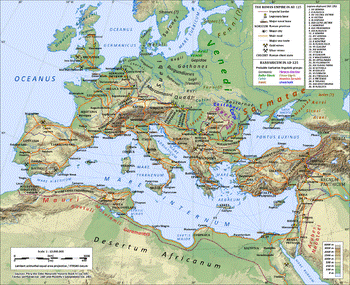
Map of the Roman empire and contemporary indigenous Europe in AD 125,
showing the location of the Thuringians in modern day Germany.
Thuringians (Thuringii)

Map of the Roman empire and contemporary indigenous Europe in AD 125,
showing the location of the Thuringians in modern day Germany.
The Thuringii or Toringi were a Germanic tribe which appeared late during the Völkerwanderung in the Harz Mountains of central Germania around 280, in a region which still bears their name to this day — Thuringia. They evidently filled a void left when the previous inhabitants — the Alamanni — migrated south to the region named after them, Alemannia. They may have been remnants of the Alemannic confederation, or simply another lesser tribe.
Political history

Europe in the late 5th century.
The Thuringii established an empire in the late 5th century. It reached its territorial peak in the first half of the 6th before it was conquered by the Franks in 531–532. Examination of Thuringian gravesites reveal cranial features which suggest the strong presence of Hunnic women or slaves, perhaps indicating that many Thuringians took Hunnic wives or Hunnic slaves following the collapse of the Hunnic Empire. There is also evidence from jewellery found in graves that the Thuringians sought marriages with Ostrogothic and Lombard women.
After their conquest, the Thuringii were placed under Frankish duces (dukes), but they rebelled and established themselves independently again by the late 7th century under Radulf. Towards the end of this century, parts of Thuringia came under Saxon rule.
By the time of Charles Martel and Saint Boniface, they were again subject to the Franks and ruled by Frankish dukes with their seat at Würzburg in the south. Under Martel, the Thuringian dukes' authority was extended over a part of Austrasia and the Bavarian plateau. The valleys of the Lahn, Main, and Neckar rivers were included. The Raab formed the south-eastern border of Thuringia at the time. The Werra and Fulda valleys were within it also and it reached as far as the Saxon plain in the north. Its central location in Germania beyond the Rhine was the reason it became the point d'appui of Boniface's mission work.
The Thuringii had a separate identity as late as 785–786, when one of their leading men, Hardrad, led an abortive insurrection against Charlemagne. The Carolingians codified the Thuringian legal customs (but perhaps did not use them extensively) as the Lex Thuringorum and continued to exact a tribute of pigs, presumably a Merovingian imposition, from the province. In the 10th century, under the Ottonians, the centre of Thuringian power lay in the north-east, near Erfurt. As late as the end of the 10th century, the porcine tribute was still being accepted by the King of Germany.